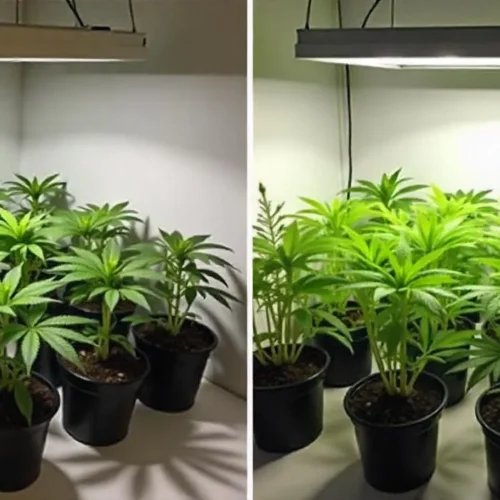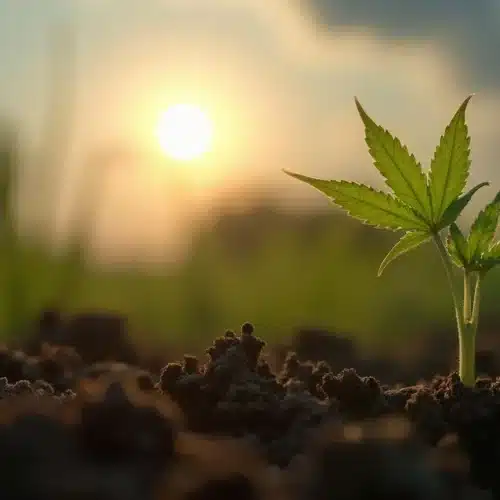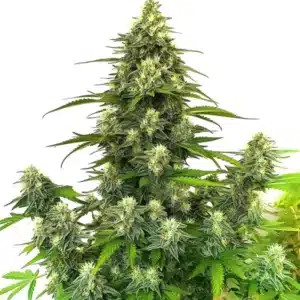Defoliating autoflowers can be a game-changer for cannabis growers looking to maximize their yields and improve the overall quality of their harvest. While it may seem counterintuitive to remove leaves from your plants, the strategic use of defoliation can enhance light penetration, improve air circulation, and ultimately lead to denser, more potent buds. In this article, we’ll explore everything you need to know about defoliating autoflowers, including the best practices, benefits, and potential risks, so you can confidently apply this technique to your grow.
The Basics of Defoliating Autoflowers
Before diving into the specifics, it’s essential to understand the basics of autoflower defoliation and why this technique is worth considering.
Recommended Strains
Grizzly Purple Auto
 THC: 9 - 13%
THC: 9 - 13% Type of seed: Autoflowering
Type of seed: Autoflowering Phenotype: Mostly Indica
Phenotype: Mostly Indica Day to flower: 8 - 10 weeks
Day to flower: 8 - 10 weeks
Grizzly Purple Kush
 THC: 15 - 20%
THC: 15 - 20% Type of seed: Feminized
Type of seed: Feminized Phenotype: Mostly Indica
Phenotype: Mostly Indica Day to flower: 8 - 10 weeks
Day to flower: 8 - 10 weeks
What is Defoliation?
Defoliation involves the deliberate removal of leaves from a cannabis plant. While the primary leaves, also known as fan leaves, play a crucial role in photosynthesis, they can also block light from reaching lower bud sites and hinder airflow within the plant. When defoliating autoflowers during flowering, growers must be especially cautious, as autoflowers have a limited vegetative period and can be sensitive to stress. By selectively removing some of these leaves, you can help the plant focus its energy on producing larger and more potent buds without compromising its growth cycle.
When it comes to autoflowers, defoliation should be handled carefully. Since autoflowers follow a fixed life cycle, their vegetative and flowering stages are determined by time, not light cycles. This makes them more sensitive to stress, so knowing the right timing and method for defoliation is key to preventing growth issues or a lower yield.
Why Defoliate Autoflowers?
The primary reason for defoliating autoflowers is to enhance light penetration and airflow within the plant canopy. Autoflowers are typically smaller than photoperiod plants, which means their canopies can become dense quickly. Without proper light and airflow, lower bud sites may not develop to their full potential, leading to smaller, less potent flowers.
Defoliation can also help prevent mold and mildew, which thrive in humid, stagnant air environments. By removing excess foliage, you open up the plant structure, allowing better air circulation and reducing the risk of moisture buildup. For growers seeking to maximize the quality and quantity of their harvest, defoliating autoflowers can be a highly effective technique when done correctly.
Promos & Deals
Benefits of Defoliating Autoflowers
Defoliating autoflowers offers several benefits that can significantly impact the outcome of your grow. By being aware of these advantages, you can make well-informed decisions on when and how to apply this technique.
Increased Light Penetration
One of the most immediate benefits of defoliation is increased light penetration. Cannabis plants rely on light to fuel photosynthesis, which in turn drives growth and bud development. However, in a dense canopy, the upper leaves can block light from reaching the lower parts of the plant, resulting in underdeveloped buds.
By strategically removing some of the fan leaves, you can allow more light to reach the lower bud sites. This not only promotes more even growth throughout the plant but also encourages the development of larger, denser buds. For autoflowers, which have a shorter life cycle, maximizing light exposure is critical to achieving a high-quality harvest in a limited time.
Improved Air Circulation
Air circulation is another crucial factor in maintaining healthy cannabis plants. Poor airflow can lead to high humidity levels within the canopy, creating an ideal environment for mold, mildew, and pests. Defoliating autoflowers helps to open up the plant structure, allowing air to flow more freely through the branches and leaves.
Improved air circulation helps to keep the plant dry, reducing the risk of mold and other issues. Additionally, it helps to regulate temperature within the canopy, preventing heat stress that can damage the plant and reduce yield. By maintaining good airflow through defoliation, you can create a healthier growing environment that supports vigorous growth and high yields.
Maximizing Bud Development
Ultimately, the goal of defoliation is to maximize bud development. By removing excess foliage, the plant can redirect its energy from maintaining leaves to producing larger and more potent buds. This is particularly important for autoflowers, which have a limited window for growth and flowering.
When done correctly, defoliation can lead to more significant bud sites, increased trichome production, and a more substantial overall yield. For growers looking to get the most out of their autoflowers, defoliation is a powerful tool that can significantly impact the quality and quantity of the final harvest.

Timing and Techniques for Defoliating Autoflowers
Timing and technique are critical when it comes to defoliating autoflowers. Because these plants have a fixed life cycle, it’s essential to know when and how to defoliate to avoid causing unnecessary stress that could impact growth and yield.
When to Start Defoliating
The timing of defoliation is crucial, especially with autoflowers. Since they transition from the vegetative stage to flowering automatically, there’s a limited window of time to perform defoliation effectively. The best time to start defoliating is during the late vegetative stage, just before the plant begins to flower. At this point, the plant is mature enough to handle the removal of leaves, but it hasn’t yet entered the critical flowering phase where stress could negatively impact bud development.
It’s important to avoid defoliating too early, as the plant needs its leaves during the early vegetative stage to build up energy reserves for flowering. Similarly, defoliating too late in the flowering stage can stunt bud growth and reduce yield. Observing your plant closely and timing your defoliation correctly is key to achieving the best results.
Step-by-Step Defoliation Process
Defoliating autoflowers requires a careful, step-by-step approach to ensure you’re removing the right amount of foliage without causing undue stress to the plant.
- Assess the Plant: Before you start, take a close look at your plant’s structure. Identify which leaves are blocking light to lower bud sites and which areas of the plant would benefit from increased airflow.
- Choose the Right Leaves: Focus on removing large fan leaves that are shading buds or preventing light from reaching the lower branches. Be careful not to remove too many leaves at once, as this can stress the plant.
- Use Clean Tools: Always use sharp, sterilized scissors or pruning shears to cut the leaves. This minimizes the risk of introducing pathogens to the plant.
- Make Clean Cuts: Cut the leaves close to the stem, but avoid damaging the main stem or branches. Clean cuts heal faster and reduce the risk of infection.
- Monitor the Plant: After defoliation, keep a close eye on your plant. Watch for signs of stress, such as wilting or slowed growth, and adjust your care routine as needed to support recovery.
Tools Needed for Effective Defoliation
Having the right tools on hand can make the defoliation process more efficient and reduce the risk of damaging your plants. Here are some essential tools you’ll need:
- Sharp Scissors or Pruning Shears: These are necessary for making clean, precise cuts. Dull tools can crush the plant tissue, leading to slower healing and increased risk of infection.
- Sterilizing Solution: Before and after defoliation, sterilize your tools with rubbing alcohol or a similar solution to prevent the spread of diseases.
- Grow Lights: Proper lighting is crucial after defoliation to support the plant’s recovery. Ensure your grow lights are positioned to maximize light penetration to the remaining leaves and bud sites.
- Fan for Air Circulation: After defoliating, improved airflow is critical. A small fan can help maintain proper air circulation around your plants, reducing the risk of mold and mildew.
Having these tools ready before you start defoliating will help ensure a smooth process and a successful outcome.
Risks and Considerations When Defoliating Autoflowers
While defoliation can offer significant benefits, it’s important to be aware of the potential risks and considerations, especially when dealing with autoflowers.
Potential Stress on Plants
Defoliation, by its nature, introduces a level of stress to the plant. For autoflowers, which have a fixed and relatively short lifecycle, this stress needs to be carefully managed. Over-defoliation, or removing too many leaves at once, can shock the plant and stunt its growth. This is particularly risky for autoflowers, as they don’t have the luxury of an extended vegetative period to recover from stress.
To minimize stress, it’s crucial to defoliate gradually. Start by removing a few leaves at a time and observe how the plant responds before proceeding further. If the plant shows signs of stress, such as drooping leaves or slowed growth, pause and give it time to recover before continuing with defoliation.
Over-Defoliation and Its Consequences
Over-defoliation is a common pitfall that can lead to several negative outcomes. When too many leaves are removed, the plant’s ability to photosynthesize is compromised, which can slow growth and reduce the overall yield. In extreme cases, over-defoliation can cause the plant to become stunted, leading to smaller buds and a less potent harvest.
To avoid over-defoliation, always err on the side of caution. Remove only the leaves that are absolutely necessary to improve light penetration and airflow. Remember that the leaves play a vital role in the plant’s energy production, so preserving as many healthy leaves as possible is important for maintaining robust growth.
How to Monitor Plant Health Post-Defoliation
After defoliating, it’s essential to monitor your plant’s health closely. The first few days following defoliation are critical, as this is when the plant will either begin to recover and thrive or show signs of stress.
Watch for any signs of wilting, discoloration, or slowed growth. These could indicate that the plant is struggling to cope with the defoliation. If you notice any of these signs, take action by adjusting your care routine. This might include increasing the amount of light the plant receives, adjusting the watering schedule, or providing a nutrient boost to help the plant recover.
Regular monitoring and quick adjustments can help ensure that your plant bounces back quickly from defoliation and continues to grow strong, healthy buds.
Comparing Defoliation with Other Training Methods
Defoliation is just one of many techniques available to cannabis growers for optimizing plant growth and yield. Let’s compare defoliation with other common training methods to understand how they differ and when you might choose one over the other.
Defoliation vs. LST (Low-Stress Training)
Low-Stress Training (LST) is a technique that involves gently bending and tying down the branches of the plant to create a more even canopy. Unlike defoliation, which involves removing leaves, LST works by redistributing the plant’s growth to maximize light exposure and airflow without causing significant stress.
LST is particularly beneficial for autoflowers because it’s a less invasive method that allows the plant to maintain all its leaves while still optimizing light penetration. This technique is often preferred by growers who want to minimize stress on their plants, especially in the case of autoflowers, where the risk of stunting growth is higher.
However, defoliation can complement LST by removing leaves that block light from reaching the lower branches. When used together, these techniques can help create a balanced canopy that maximizes light exposure and airflow, leading to better overall yields.
Defoliation vs. Topping
Topping is another popular training technique that involves cutting off the top of the plant to encourage the growth of multiple main colas. Like defoliation, topping can be stressful for the plant, but it’s often used to increase the number of bud sites and create a more even canopy.
For autoflowers, topping can be risky due to their short lifecycle. The plant may not have enough time to recover from the topping before it starts flowering, which can lead to reduced yields. Defoliation, on the other hand, is less extreme and can be done more gradually, making it a safer option for autoflowers.
When deciding between defoliation and topping, consider the specific needs of your plant and your growing goals. If you’re looking to create more bud sites, topping might be the right choice, but if your goal is to improve light penetration and airflow without significant stress, defoliation could be the better option.
Combining Defoliation with Other Techniques
Many growers find that combining defoliation with other training techniques, such as LST or topping, can lead to the best results. By carefully timing and balancing these methods, you can optimize your plant’s growth and maximize yield.
For example, you might start with LST to create a more even canopy, then use defoliation to remove any leaves that block light from reaching the lower bud sites. This combination allows you to take advantage of the benefits of both techniques while minimizing the risks associated with each.
When combining techniques, it’s essential to monitor your plant’s response and adjust your approach as needed. Each plant is unique, and what works well for one may not be ideal for another. By experimenting with different combinations, you can develop a personalized approach that works best for your specific growing conditions and goals.
Optimizing Your Grow with Defoliation
To get the most out of defoliating autoflowers, it’s essential to integrate this technique into your overall growing strategy. By balancing defoliation with other key aspects of plant care, you can enhance yield and quality while minimizing potential downsides.

Balancing Defoliation with Nutrient Management
Nutrient management plays a crucial role in the success of defoliation. After removing leaves, the plant needs to recover and continue growing vigorously, which requires a well-balanced nutrient regimen. Providing the right nutrients at the right time can help the plant bounce back quickly and direct its energy towards developing larger, more potent buds.
Focus on providing nutrients that support both vegetative growth and flowering. During the vegetative stage, nitrogen is critical for leaf and stem development, while phosphorus and potassium become more important during flowering. After defoliation, consider giving your plants a slight boost of nitrogen to help them recover, followed by a balanced feeding schedule that supports bud development.
Avoid over-fertilizing, as this can cause nutrient burn and stress the plant further. Instead, aim for a steady, balanced approach that meets the plant’s needs without overwhelming it. By synchronizing your nutrient management with defoliation, you can ensure that your plants remain healthy and productive throughout their growth cycle.
Enhancing Yield Through Strategic Defoliation
Strategic defoliation can be a powerful tool for enhancing yield. The key is to approach it methodically, removing only the leaves that are truly hindering light penetration and airflow. By focusing on these critical areas, you can create a more efficient plant structure that directs energy towards bud production rather than maintaining unnecessary foliage.
One effective strategy is to combine defoliation with other training techniques, such as Low-Stress Training (LST) or topping. By bending branches or removing the top of the plant, you can encourage a more even canopy, which defoliation can further enhance by ensuring light reaches all parts of the plant. This combination of techniques can lead to larger, more uniform buds and a higher overall yield.
Another strategy is to time defoliation to coincide with key growth stages. For example, defoliating just before the flowering stage can help prepare the plant for bud development by ensuring that light and nutrients are directed towards the buds rather than excess foliage. By timing defoliation strategically, you can maximize the impact on yield.
Long-Term Benefits of Defoliating Autoflowers
The benefits of defoliation extend beyond just a single grow cycle. By consistently applying this technique, you can improve the overall health and productivity of your plants over time. Plants that are regularly defoliated tend to develop stronger stems and branches, which can support larger buds and reduce the risk of breakage during flowering.
Additionally, the practice of defoliation allows you to gain greater insight into your plants and their needs. By observing how your plants react to defoliation, you can adjust your techniques and improve your ability to manage plant growth. This enhanced experience can lead to better outcomes in future grows, whether you stick with autoflowers or try other cannabis varieties.
Another long-term benefit is the potential to reduce issues related to pests and diseases. By maintaining a more open and well-ventilated plant structure, defoliation can help prevent the conditions that favor mold, mildew, and pest infestations. This proactive approach to plant care can lead to healthier plants and more bountiful harvests over the long term.
FAQs
What is defoliation and why is it used on autoflowers?
Defoliation is the selective removal of fan leaves from a cannabis plant to improve light penetration and airflow within the canopy. For autoflowers, defoliation helps ensure that lower bud sites receive adequate light and reduces the risk of mold by improving air circulation. When done correctly, it allows the plant to focus energy on producing larger, denser buds.
When is the best time to defoliate autoflowers?
The ideal time to defoliate autoflowers is during the late vegetative stage, just before flowering begins. At this point, the plant is mature enough to handle leaf removal without experiencing significant stress. Avoid defoliating too early or too late in the plant’s lifecycle, as this can disrupt growth and negatively impact yields.
What are the risks of defoliating autoflowers?
While defoliation offers benefits, it also carries risks, especially for autoflowers with their fixed growth cycle. Over-defoliation can stress the plant, slow growth, and reduce yields. To minimize risk, remove only the necessary leaves gradually and monitor the plant for signs of stress such as drooping or discoloration.


















